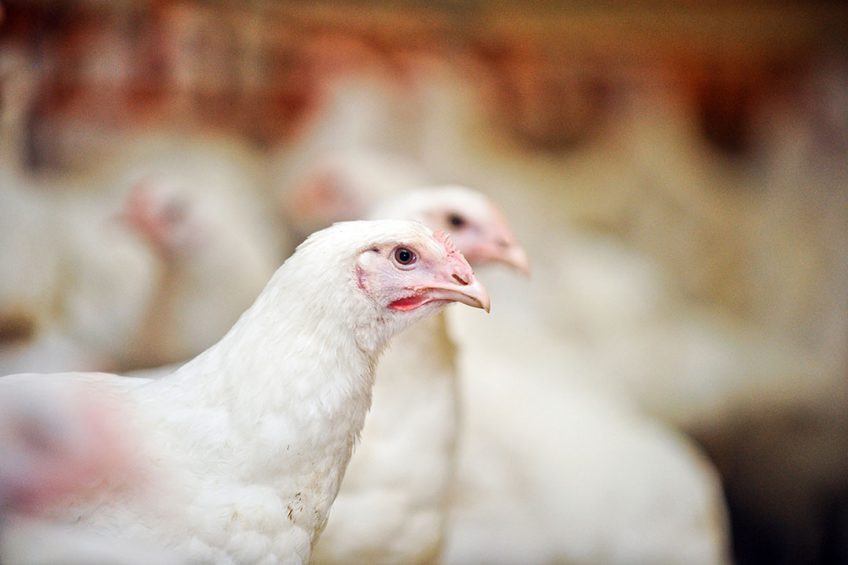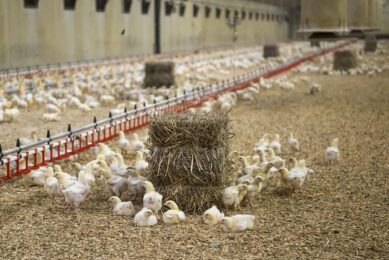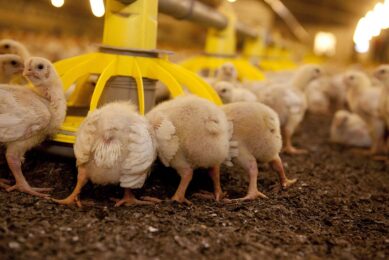Insects as a tool against fowl typhoid disease

Small amounts of Black soldier fly larvae meal can boost the immune system of broiler chicken and drastically increase their survival rate during fowl typhoid disease.
Black soldier fly larvae (BSFL) meal gains more and more attention as protein-rich soy and fishmeal substitute in animal feed. In the diet of broiler chicken, BSFL can replace a substantial amount of soy without detrimental effects on the animal’s performance. However, BSFL has an even wider impact on broiler chicken performance, which could be quite significant in in commercial farming settings.
Studying the immune response
In a recent study by Lee et al. (2018) the effects of BSFL meal inclusion on the immune response of broiler chickens to Salmonella enterica serovar Gallinarum (S. Gallinarum) was investigated. S. Gallinarum, a Gram negative bacterium, causes fowl typhoid that often leads to anorexia, diarrhoea, dehydration, but also anaemia, hepatosplenomegaly (enlarged liver and spleen) and bleeding of the intestinal tract of chicken, and high mortality rates in flocks (Shivaprasad, 2000; Lee et al., 2007). Overall, fowl typhoid represents a major problem for the poultry industry in Asian countries, such as Korea and India (Barbour et al., 2015). The inclusion of BSFL meal even in relatively small amounts in the diet resulted in enhanced immune responses in broiler chicken, as well as reduced mortality and improved pathogen clearance when broiler chicken were challenged with S. Gallinarum. This was, furthermore, accompanied by increased gain in body weight. Even though S. Gallinarum is extinct in most European countries and North America, the results of this study suggest overall prophylactic properties and a stimulation of the non-specific immune response in broiler chicken when BSFL meal is included in their diet. This, in turn, could have beneficial effects on the productivity of poultry industries in general.
BSFL increases immune system markers
During the experiment, broiler chicken received feed with 1%, 2% or 3% BSFL meal inclusion (percentage by mass) from day one. At day 20, the spleens of the chickens were extracted, and isolated spleen cells were investigated for the ratio of the T lymphocyte subpopulations CD3+ and CD4+. Both cell types are highly effective markers for immune system activation (Fair et al., 2008; Abdukalykova et al., 2008). The amount of CD3+ and CD4+ cells was significantly higher in chicken fed with BSFL meal compared with the control group that was not fed BSFL meal. Notably, the amount of CD3+ and CD4+ cells increased in a dose dependent manner. With 2% BSFL inclusion, P<0.05, and with 3 % inclusion, p><0.01. these results indicate that the inclusion of 2% and 3% bsfl meal aid immune function in broiler chicken. furthermore, the proliferation of spleen lymphocytes was also significantly increased in a dose dependent manner in bsfl fed broiler chicken. with 2% bsfl inclusion, p><0.05, and with 3% inclusion, p><0.01. these results imply that the inclusion of 2% and 3% bsfl meal enhance mitogenicity of lymphocytes in broiler chicken.>
Higher lysozyme activity
In conjunction with these results, the lysozyme activity in the blood serum of broiler chicken that were fed the 2% and 3% BSFL inclusion diet was also higher. With 2% BSFL inclusion, P<0.05, and with 3% inclusion, p><0.01. lysozyme is an enzyme that degrades bacterial cell walls and is associated with increased effectiveness of phagocytes such as macrophages (white blood cells that clear microorganisms and other foreign substances), and granulocytes (also a type of white blood cells that act against bacteria, fungi and parasites). these results implicate that 2% and 3% bsfl meal inclusion in the feed enhances the destructive effect of phagocytes in broiler chicken.>
BSFL significantly mitigates fowl typhoid disease
In a subsequent infection assay to determine the immunomodulation effects of BSFL meal inclusion, 18 days old healthy broiler chickens were challenged with S. Gallinarum (oral infection with 5×1010 cfu, which represents a high artificial concentration that is commonly not encountered in natural oral infection). Overall, the chicken fed with BSFL diet showed delayed mortality by two to three days compared to the control group that started to die at day three post infection. But even more crucial, at day 15 the final survival rate in the BSFL diet group was significantly higher than in the control diet group, again, in a dose dependent manner: control group with 50% survival rate, 1% BSFL inclusion with 67 %, and 2% with 75%. The inclusion of 3% BSFL resulted in especially high survival rate with 85%. In the literature, mortality rates of up to 100% have been reported, and two to three weeks old animals seem to be particularly affected and susceptible (CFSPH, 2009; Shivaprasad, 2000; Barrow and Neto, 2011). These results show that even relatively low amounts of BSFL meal in the diet leads to increased survivability of broiler chicken that are artificially infected by S. Gallinarum.
Clearance of the pathogens
The amount of viable S. Gallinarum in liver, spleen, bursa of Fabricius (an organ in birds that is essential to the development of B cell, which are part of the immune system), and caecum (beginning of the large intestine) of challenged broiler chicken were significantly decreased in the 2% and 3% BSFL diet group in a dose dependent manner compared to animals in the control diet group at 16 days post infection (significantly in liver, spleen and caecum for 2% (P<0.05) and 3% (p><0.01), and significantly in bursa for 3% (p><0.01)). these results suggest a bsfl-mediated enhanced clearance of>S. Gallinarum upon infection.
Improved broiler chicken growth
Previous studies already suggested that immune response stimulating agents could improve broiler chicken growth due to an improved health status (Landy et al., 2011; Faluyi et al., 2015). This hypothesis was confirmed in the present study by Lee et al. (2018). The BSFL-fed broiler chicken showed enhanced weight gain and reached the target body weight of 1.3kg two days earlier than the broiler chicken fed with the control diet (30 days instead of 32 days).
Conclusion
In conclusion, the results of the immunological markers and infection assay could imply that components in BSFL act as non-specific immune response stimulating agents and enhance immunity in broiler chicken against bacterial pathogens in general. It could be argued that small amounts of BSFL can be added in the chicken feed as an agent with prophylactic properties against diseases in the commercial farming sector. After all, the significantly increased survival rates in the experimental infection assay is a compelling economical reason, and BSFL are more sustainable than the use of other agents such as antibiotics. However, the components in BSFL that are responsible for the observed immune system enhancing effect are still unknown and future studies could aim at investigating them.
References are available on request.
Join 31,000+ subscribers
Subscribe to our newsletter to stay updated about all the need-to-know content in the poultry sector, three times a week. Beheer
Beheer








 WP Admin
WP Admin  Bewerk bericht
Bewerk bericht